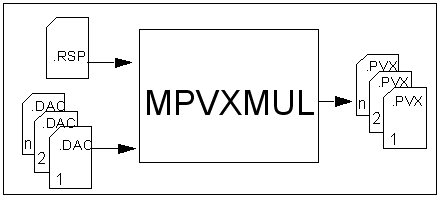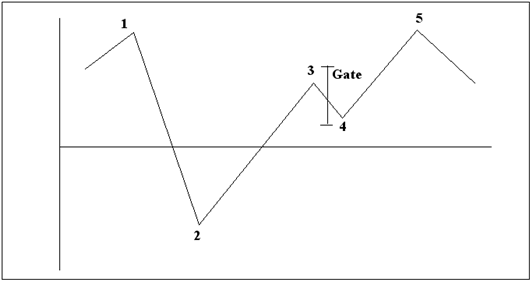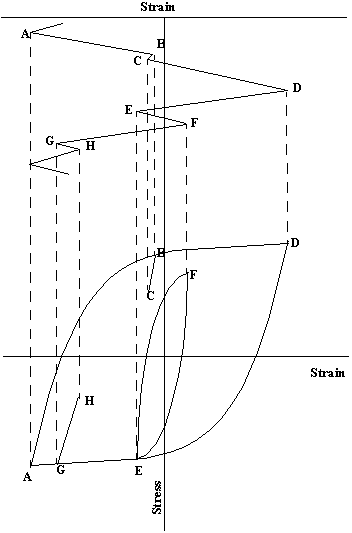XXXXXXXXXXXXXXXXXXXXXXXXXXXXXXXXXXXXXXXXXXXXXXXXXXXXXXXXXXXXXXXXXXXXXXXXXXXXXXXXXXXXXXXXXXXXXXXXXXXXXXXXXXXXXXXXXXXXXXXXXXXXXXXXXXXXXXXXXXXXXXXXXXXXXXXX''"> Peak-Valley Extraction (MPVXMUL)
This program performs peak valley extraction i.e. it extracts turning points (maxima and minima or “peaks” and “valleys”) from single parameter files such as .dac and on RPC multiple data-channel files. The analysis is performed such that the phase relationship between all the channels is not lost, when peaks and valleys occur on different channels at different times. To invoke this program from the system prompt you type mpvxmul.
A hysteresis gate can be set independently for each channel, allowing small oscillations on the data (noise) to be ignored.
Output files are created, one per channel (RPC files), or one per .dac file. All outputs are .dac files. Extra details, such as equivalent units, are automatically transferred to the output file.
Input Data Files, .dac and MTS RPC
Single parameter .dac files can be processed by MPVXMUL. These exist as families of files with a common generic name, but with different numbers appended to the name which denotes the channel number. For example test01.dac for channel 1, test02.dac for channel 2, etc. test is the generic name.
Remote parameter RPC multiplexed files from MTStmcan also to loaded into MPVXMUL and each channel converted into .pvx files. Both RPC II and III file types can be processed. See the MTS documentation for full details of their RPC file types.
The Range Method
Whatever the input, an output .pvk (Peak Valley extraction) file will be generated for each channel processed.
Within a time series, a turning point is defined as a local peak or valley, i.e. a value within the time series at which its direction changes. At the start of the peak-valley process, only one turning point can be defined with any certainty and that is the largest absolute value in the signal, be that the signal maximum or minimum. MPVXMUL starts its processing at this point and continues on to the end of the signal, then it loops back to the start of the data until the absolute maximum start point is reached again. The peak-valley values are written out to the output file in the original sequence, i.e. starting with the first. This form of output is exactly what is required by the critical location fatigue analyzer, FEFAT.
During the course of the peak-valley extraction process, the number of turning points detected can be restricted by imposing a hysteresis “gate”. This gate corresponds to the smallest difference between adjacent turning points that can be accepted. For turning points to be counted, they must be separated by a distance greater than the specified gate. By these means, small disturbances or “noise” in the time series may be “gated out” from the set of extracted turning points.
Figure 4‑31 Hysteresis Gate
In
Figure 4‑31 turning points 3 and 4 will not be counted since their separation is less than the specified gate.
MPVXMUL can process the input time series data file in its entirety or just a selected portion. The analysis can begin at a particular time, by default this time is 0.0 i.e. the start of the signal, and end at another time, greater than the start time, usually the end of the signal. By these means it is possible to define a time window for the peak-valley extraction process.
The output data file (.pvx extension) contains turning points in physical units and has the same file format as the input data file (.dac extension). The output file can therefore be manipulated and displayed for example using PTIME or MMFD.
Any information stored in the Extra Details Area of the input file are automatically carried forward to .pvx file. The EQUUNITS and NUMEQUNI values are carried forward so that the fatigue analyzer FEFAT can report predicted limits in equivalent units.
The Rainflow Procedure Method
The rainflow algorithm used by MPVXMUL is based on the standard practice for cycle counting in fatigue analysis as defined by the ASTM designation E 1049-85, (See ASTM standards Vol. 03.01). Under these circumstances, the rainflow cycle count will be identical to a range pair cycle count which itself starts at the largest value. Differences in the results produced by the two procedures only arise if processing starts at some value other than the absolute maximum.
It is possible to illustrate the rainflow cycle counting procedure used by considering the simple strain time series shown in
Figure 4‑32 below.
Figure 4‑32 Illustration of the Rainflow Procedure
Figure 4‑32 shows a strain sequence of four turning points, and the stress-strain response of a material to this sequence. The closed hysteresis loop is a cycle, which may be characterized in terms of its strain range and mean strain.
If the stress axis of this diagram is ignored and only successive strain ranges are considered, then an algorithm can be developed which will extract cycles from a signal whatever its units. The rainflow algorithm is able to extract cycles in the way described above, classify them in terms of their range and mean value, and store them in a range mean matrix.
The term rainflow derives from an algorithm, in which cycles are extracted through a consideration of rain drops flowing down a pagoda roof. Modern algorithms no longer use this concept although the generic name “rainflow” still persists.
Module Operation
The first screen allows the type of input files to be selected. The program will work with multiple .dac files or RPC files.
Normally, file type selection is available, as illustrated above, but the file type may be fixed before running MPVXMUL by setting the environment variable $SIMXTYP equal to DAC or RPC.
There is therefore two distinct paths through MPVXMUL; however, they differ only in detail.
If .dac files are being processed then a generic .dac file name must be supplied.
If RPC files are being processed then only a single file name has to be supplied.
The next few screens presented will request that certain parameters be set. These are explained here.
Field | Description |
Generic Input File Name | The family of .dac files which are specified for input must all have names which are constructed as follows: <generic name><channel number>.dac where the generic name is the same for all the files. The channel numbers are two or three digits padded with a leading zero where required. The generic name should be entered in this field. A directory path may be included if required. |
Channels | Up to 999 channel numbers may be specified by entering them in the form 1,3-15,35-60, etc. where the hyphen represents an inclusive range of channel numbers. Alternatively, the word 'ALL' may be entered in the answer field to indicate the use of all the channels which match the given generic name. |
Output File Name | One output file is created for each input channel processed. The output file names are also constructed according to the generic name plus channel number syntax described above. Enter the generic part of the output file names in this field. This name may include a directory specification if the output files are to be written into a different directory. The extension of all the output files will be .pvx. If one or more of the output files already exist with the specified name, the program will ask whether to overwrite the existing files or not. If the answer is NO, then a different output file name will be requested. |
Input data time span | This is purely for display purposes and is a statement of the length of the input data files, and the number of points that each of them contains. |
Set Limits As | This field and the following two allow a section of the input file(s) to be processed, rather than processing the complete file(s). This is done by setting a start and end position. This field determines the method by which the start and end position are to be set, the options being Time or Point number. The following two fields, specifying the start and the end position, will be changed to reflect the appropriate units. |
Start Position/Time | As described above, this field may be either Start Time or Start Point. Times are measured from the time origin, which is normally, but not necessarily always, the start of the file. Points are numbered from 1 at the beginning of the file. The word 'START' may be entered signifying the start of the data. |
End Position/Time | This field sets the end position in the chosen units. The word 'END' may be entered signifying the end of the data. |
Gate Method Range\Cycles | Choose the method by which data values will be gated. Range - each consecutive range value is checked against the specified gate. The reference value is the maximum range of the data which MPVXMUL determines before gating out those values that are less than the specified percentage of the maximum range. This is the method used by previous versions of PVX and MPVXMUL and is included for compatibility reasons. Cycle - A rainflow analysis is performed and the size of the cycles are then compared to the specified gate value. This involves an intermediate stage in which a rainflow file is created and means that it is possible for non-consecutive points to be extracted or excluded. This method is smarter and produces superior fatigue analysis results. |
Gate Values | When the above fields have been defined, MPVXMUL moves onto the Hysteresis Gate Setting screen. This screen allows the gate value to be set independently for each input channel. The gate value may be set directly in the units of the data on the channel, or may be entered as a percentage. If a percentage, the actual gate value used will be that percentage of the maximum range of the data on the respective channel. This screen may consist of more than one page, since only 16 channels can be displayed at once. To move between the pages, use the Page Up, Page Dn, Home and End keys. |
The fields are as follows:
On completion of all input parameters, the analysis will be performed and the results files written to disk.
A processing summary screen is displayed.
Batch Mode (MPVXMUL)
The following keywords are defined for batch mode operation:
/TYpe | Type of input file either D or R (/TY=D) |
/GENeric | Input generic file name (/GEN=test) |
/CHAnnels | Channels (/CHA=5,7,9,11) |
/OUTput | Output file name (/OUT=fred) |
/OVerwrite | Overwrite output files Y, N (/OV=Y) |
/METhod | Limit setting method, either T or P (/MET=P) |
/STArt | Start position (/STA=10) |
/END | End position (/END=20) |
/GATMTH | Gate method, either R or C (/GATMTH=R) |
/GATe | Gate value (absolute value) |
/PGATe | Percentage gate value (% of range) |
/CGATxxxx | Gat value for channel xxxx, where xxxx is zero padded, i.e., channel 1 is 0001. This is only available if GAT or PGAT are not used. |
/*=TT | If the user wishes to see output sent to the screen, he must include this parameter exactly as shown. Any other value other than TT after the equal sign will send the output to a file by that name. |
Example:
mpvxmul /ty=d/gen=test/ov=y/cha=all/met=t/sta=start
/end=end/gatmth=r/pgat=50



